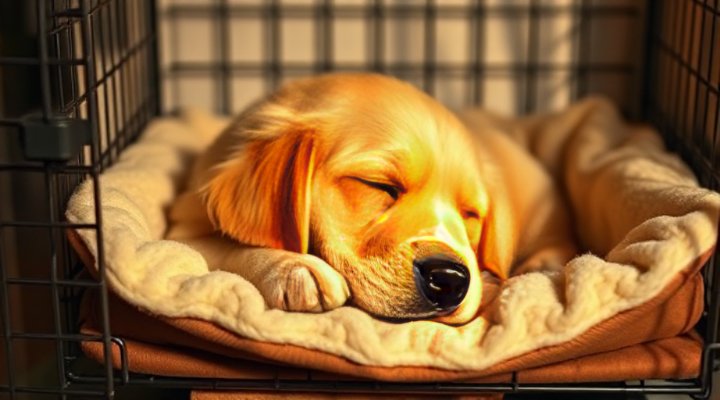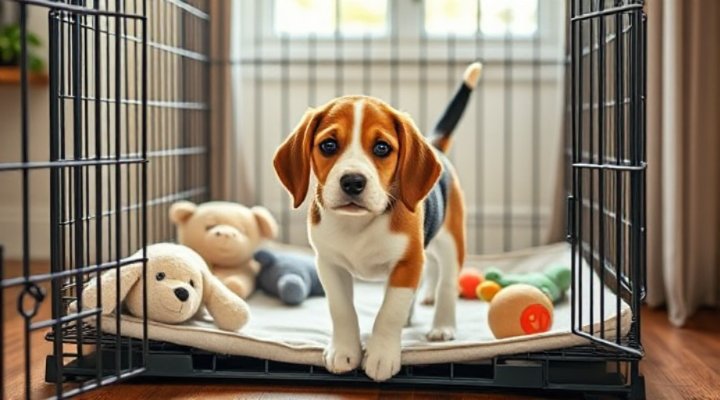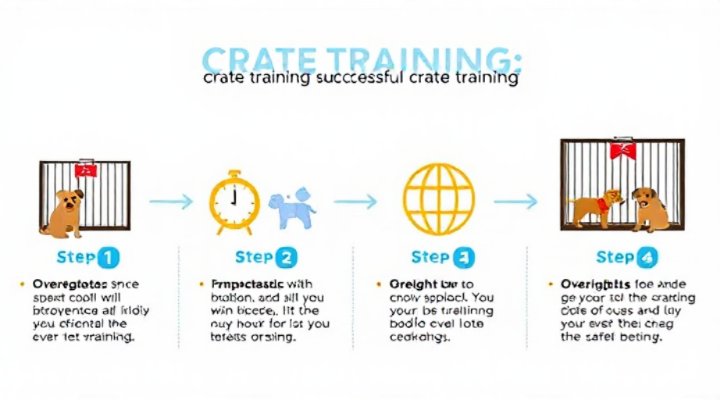Crate training is one of the most valuable skills you can teach your new puppy. When done properly, puppy and crate training creates a safe space for your dog while helping with housebreaking and preventing destructive behaviors. The key is making the crate a positive place your pup willingly enters.

Why Crate Training Benefits Your Puppy
Dogs are den animals by nature, and a properly introduced crate taps into this instinct. According to the American Veterinary Society of Animal Behavior, crate training done positively can:
- Provide a safe retreat when your pup feels overwhelmed
- Speed up housebreaking by taking advantage of dogs’ natural cleanliness
- Prevent destructive chewing when unsupervised
- Make travel and vet visits less stressful
Our comprehensive puppy training guide covers additional foundational skills every young dog should learn.

Choosing the Right Crate
The foundation of successful puppy and crate training starts with proper equipment. Here’s what to look for:
Crate Type
Wire crates offer excellent ventilation and visibility, while plastic crates create a more den-like atmosphere. Soft-sided crates work well for travel but aren’t ideal for chewers.
Proper Sizing
The crate should be just large enough for your pup to stand, turn around, and lie down comfortably. If housebreaking is a priority, consider a crate with a divider to adjust as your puppy grows.
For more on selecting equipment, see our scientific approach to crate training.

Step-by-Step Crate Training Process
Rushing the process is the most common mistake in puppy and crate training. Follow these gradual steps:
Stage 1: Introduction (Days 1-3)
Place the crate in a busy family area with the door open. Sprinkle treats inside and let your puppy discover it naturally. Never force entry.
Stage 2: Positive Associations (Days 4-7)
Feed meals near the crate, then inside with the door open. Use special chew toys only available in the crate.
Stage 3: Short Confinement (Week 2)
Begin closing the door for 5-10 minutes while you’re present, gradually increasing time as your pup remains calm.
Stage 4: Alone Time (Week 3+)
Start leaving the room for brief periods, then longer absences. Always return before your puppy becomes distressed.
For puppies with separation anxiety issues, this stage may take longer.

Troubleshooting Common Crate Training Challenges
Whining or Barking
If your puppy vocalizes, wait for a quiet moment before releasing them. Responding to noise teaches that complaining works.
Accidents in the Crate
This usually means the crate is too large, the puppy was left too long, or needs more frequent potty breaks. Review our housebreaking guide.
Reluctance to Enter
Go back to earlier stages, using higher-value treats. Make the crate more appealing with comfortable bedding and familiar scents.

Advanced Crate Training Tips
Once your puppy is comfortable with basic crate training, try these enhancements:
- Practice crate commands like “kennel up” with happy reinforcement
- Occasionally leave special treats or food puzzles in the crate
- Move the crate to different rooms to generalize the behavior
- Use the crate for brief calm periods even when you’re home
Remember, every puppy learns at their own pace. What took one week for my Labrador mix took nearly a month for my anxious rescue. The Humane Society offers excellent additional resources for persistent cases.
When to Phase Out the Crate
Most dogs continue to enjoy their crate into adulthood, but you can begin giving more freedom when:
- Your dog is completely housebroken
- Destructive chewing phase has passed
- They can be trusted alone without getting into trouble
- They voluntarily choose to sleep in the crate with the door open
Even after phasing out required crate time, keep it available as a safe space. Many adult dogs continue using their crate as a bedroom.
For more puppy training advice, explore our tips for cultivating good behavior from an early age.
Related Keywords:
crate training schedule, puppy crate size, best dog crates, crate training at night, how long to crate train, crate training benefits, crate training mistakes, introducing puppy to crate, crate training resistant dogs, crate training for separation anxiety

